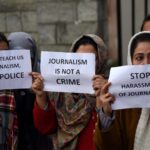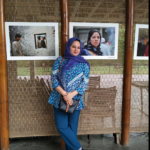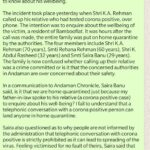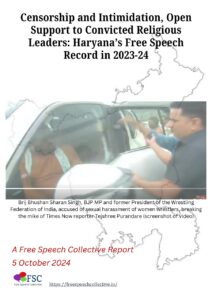
Journalists in India are being intimidated and harassed by governments trying to manage a pandemic by simply censoring uncomfortable reports. FSC brings you a list of ten instances of serious charges against journalists for their reports.
World Press Freedom Day dawns over a globe fraught with the sorrow of more than 200,000 deaths and a confusing, uncertain future with prolonged lockdowns, stringent physical distancing and an economic collapse. Journalists navigate this surreal and dystopian time, bringing news to the locked in public, at considerable risk to themselves. They have faced job losses, salary cuts, several media persons across the country have tested positive for working on the field with little or no safety precautions and PPEs.
Yet, many of them are being intimidated and harassed by governments trying to manage a pandemic by simply censoring uncomfortable reports. FSC brings you a list of ten instances of serious charges against journalists for their reports.
Across the world, as the RSF (Reporters Sans Frontières/Reporters Without Borders) 2020 World Press Freedom Index says, authoritarian governments are cracking down on press freedom in the name of combating the Covid-19 pandemic.
The International Federation of Journalists (IFJ), in its report released today, said: “The media had the task of reporting the growing humanitarian crisis, working in difficult circumstances and amidst unprecedented physical curbs due to lockdowns and restrictions, particularly in containment zones. The Covid-19 crisis has exacerbated existing fault lines in the precarious freedoms that the South Asian media has fought for and the most vulnerable are now taking the first beating.”
(Download full report here)
In India, the government led with the ‘appeal’ by Prime Minister Narendra Modi to editors and owners of top print media houses, hours before the nation-wide lockdown was announced on Mar 24, to publish positive stories and ‘act as a link between government and people.’ The media owners assured the government that ‘they will work on the suggestions of the Prime Minister to publish inspiring and positive stories.’
Other state governments issued notifications that the media must carry only official reports while the Telangana Chief Minister went a step further to ‘curse’ the media that they would get the coronavirus for reporting an alleged attack on a doctor by a relative of a person who tested positive for coronavirus!
Despite government advisories that the news media is an essential service and that no one should lose their jobs or face wage cuts, more than 10 news media establishments shut down, terminated workers or effected steep salary cuts in the wake of the lockdown. A writ petition challenging these were filed in the Supreme Court by the National Alliance of Journalists, the Delhi Union of Journalists and the Brihanmumbai Union of Journalists and admitted on April 27.
The control on content began bright and early. On March 31, in response to a petition, the Union government actually asked the apex court to direct the media to publish nothing about the pandemic unless it was cleared by the government first! It was clearly pre-censorship and while the Supreme Court did say it did not want to interfere does not intend to interfere with the free discussion about the pandemic, it actually “directs the media to refer and publish the official version about the developments”.
(Read SC order here)
The court appeared to completely accept the government’s status report that the migration of workers ‘was triggered by panic created by fake news that the lock down would continue for more than three months’.
Today, of course, we know that the four-hour deadline for the March 25 lockdown, now extended till May 17 in major metros, has caused untold suffering for scores of people and actually resulted in the deaths of migrants, not due to Covid-19 but due to hunger and the extreme exhaustion of those who attempted a desperate walk back home!
FSC list
Since March 25, when the nation-wide lockdown was announced in India, police and authorities have questioned, filed cases or arrested at least 10 journalists in India for reports on the sub-standard quality of PPEs, on quarantine conditions or the plight of migrant workers.
- On April 30, Manish Pandey, a journalist of Hindi news channel News1 India, was interrogated by the Special Task Force of Uttar Pradesh police for his report on the poor quality of personal protective equipment (PPE) kits supplied to supplied to eight hospitals and medical colleges in the state. Pandey’s story, aired on April 17 referred to a letter written by the Directorate General of Medical Education and Training, Uttar Pradesh on April 13. The interrogation, the news channel said, went on for more than an hour and police tried to find out the source of his information.
A newslaundry report says that the police denied the interrogation but did confirm that the journalist was called for a chat over a cup of tea!
But if the police had an issue with his report, why couldn’t they write a letter stating their objections or even lodge a formal complaint with the news channel? This is sheer intimidation.
- On April 27, journalist Zubair Ahmed posted a tweet that posed a simple question to the Andamans administration: Can someone explain why families are placed under home quarantine for speaking over phone with Covid patients?
Ahmed was referring to a report in the website Andamanchronicle about a famil of four who were put into home quarantine because one of them, 70-year-old K A Rehman, called up a relative who had tested positive for Covid-19 to enquire about his health. For questioning the authorities, Ahmed was arrested u/s 188 (disobedience to order duly promulgated by public servant), 269 (negligent act likely to spread infection of disease dangerous to life) and 505 (1) (publishing or circulating any statement, rumour or report) of the Indian Penal Code. If that was not enough, the Andamans administration also threw Sections 51 and 54 of the Disaster Management Act, 2005, at him. He managed to secure bail the next day.
But why was he arrested in the first place? And why does he still face charges? This is totally illegal.
3. On April 26, Neeraj Shivhare, a journalist based in Dantewada, Chhattisgarh, was given a showcause notice by a sub divisional magistrate for his report on on his website Bastar Ki Aawaz on the plight of a woman who had to sell her fridge to buy rations. According to a report in Newslaundry, the notice says:
“The whole nation is dealing with the pandemic and publishing such posts can create an atmosphere of fear in the public. The post has damaged the image of the administration, therefore this action of yours has disregarded the order of administration and comes under the category of punishable offence.”
The notice said the story was ‘misleading’ but as the report later pointed out, the story was true. A supporting video as well as the quotes from the woman and her husband confirm that it was only after the story broke that the administration woke up to their plight and made arrangements to supply them with milk for the child!
How on earth is a story about the desperation of this family to have to sell an appliance to procure milk for their infant a punishable offence? This is intimidation and harassment.
- On April 24, Andrew Sam Raja Pandian, a digital journalist and founder of in, a Coimbatore-based news site, was arrested for publishing two reports, the first about corruption in the government food distribution and the second about problems faced by doctors in the city. He was charged under sections 188 and 505 (i) of the IPC and Section 3 of the Epidemic Diseases Act. Pandian was released on bail on April 28. Initially, the reporter and photographer of the reports under question, Jerald Aruldas and M Balaji, were detained and interrogated by police for over nine hours.
In an interview, Aruldas said, “The police did not hurt me or Balaji. We were not interrogated, just made to sit there for long hours. But it was still a very intimidating experience. There is an air of fear in the local media. Every media person is now scared of covering news related to COVID-19.”
In Kashmir, FIRs were registered against three journalists in the span of five days, including under the draconian Unlawful Activities (Prevention) Act (UAPA). Already facing a repressive and debilitating Internet shutdown that has made routine work almost impossible for the local media, the three cases were clearly intending frighten local journalists and send a message to them to behave or else…
(read statements condemning the FIRs here)
(read petition filed by the Foundation for Media Professional seeking restoration of 4G Internet services in the Valley here)
- On April 18, the Cyber Police Station (Kashmir Zone) lodged an FIR against photojournalist Masrat Zahra under section 13 of the draconian Unlawful Activities (Prevention) Act, and Sec 505 of the Indian Penal Code for uploading allegedly “anti-national” posts with the criminal intention to induce the youth and promote offences against public tranquility. No specific post was mentioned and the photojournalist was only identified as a ‘Facebook user’ in the police press release.
The case against Zahra , shockingly under the draconian act that prevents those charged from even applying for bail for upto 90 days, received widespread condemnation. Zahra had been filing photographs of Kashmir under the lockdown on her Facebook page and had done a report on the plight of Arifa Jan, the widow of a man who was killed by the Indian security forces in 2000.
- On April 21, The Hindu correspondent in Srinagar, Peerzada Ashiq, was questioned by the Cyber Police in Srinagar and later by the Anantnag police for his report “Kin allowed to exhume bodies of militants in Baramulla” published by The Hindu on April 19. Police said the news was ‘fake’ and registered an FIR on April 20.
Interestingly, the police press release also echoed the ‘annoyance’ of the authorities that their ‘version’ was not sought: “The news was published without seeking confirmation from the district authorities,” the press release said.
- On April 22, journalist Gowher Geelani was booked by the Cyber police, Srinagar, for allegedly ‘indulging in unlawful activities’ through his posts and writings on social media. Cyber police, which merely identified him as ‘an individual namely Gowher Geelani’, said he was indulging in unlawful activities through his posts and writings on social media platform which are prejudicial to the national integrity, sovereignty and security of India”.
Again, none of these posts were specified. The press releases also deliberately refused to specify the profession of the journalist, denying them the agency of their work.
- On April 16, police in Mumbai arrested journalist Rahul Kulkarni of ABP Mazha television channel for broadcasting a report of an internal memo on preparations by railway authorities to start long distance train services. The report, police said, was responsible for the assembly of scores of stranded migrant workers outside the Bandra train terminus to purchase tickets. An FIR was also lodged against a political activist Vinay Dubey, for uploading videos about getting stranded migrants home.
The journalist was released on bail and the channel issued a statement denying any link with its broadcast and the assembly of people. The channel said “the story was broadcast in public interest and on the basis of valid documents and information and there was no conceivable way in which the crowds that gathered at the station from around 3:45 pm could be linked to its stories aired.”
9. On April 14, journalist Ashlin Mathew of The National Herald, Former IAS officer Kannan Gopinathan and senior advocate Prashant Bhushan, were booked by Rajkot police for “posting and retweeting” a tweet on March 28 that allegedly “insulted a religion with intention to create fear or alarm among people”. An FIR was lodged at Bhaktinagar police station on April 12 against them under sections 295 (injuring or defiling place of worship with intention to insult the religion of any class), 505 1 (B) (intent to cause fear or alarm among public), 35 (acts done by several persons in furtherance of common intention) and 120 B (criminal conspiracy) of the IPC.
The offending tweet, posted on March 28 by Prashant Bhushan, retweeted a tweet by Union Minister Prakash Javadekar with his photo saying “I am watching ‘Ramayana’, are you? (sic)” to which Bhushan commented “As crores starve and walk hundreds of miles home due to forced lockdown, our heartless ministers celebrate consuming and feeding the opium of Ramayana and Mahabharata to the people (sic)”. Bhushan’s tweet was allegedly retweeted by Gopinathan and Mathew, the FIR said.
In the absurd theatre of FIRs and arrests, the complainant, identified as an army veteran Captain Jaidev Joshi, took offence to the use of the word ‘opium’ in the tweet! According to the news report, V K Gadhvi, officer in charge of Bhaktinagar police station, the case was transferred to the Rajkot Special Operations Group (SOG). It is reported that Javadekar deleted his tweet so one can only hope the new investigating officer will include the entire original 1843 quote by philosopher Karl Marx as additional evidence.
- On April 1, An FIR was lodged against The Wire and one of its founding editors, Siddharth Varadarajan, for allegedly posting false news about the participation of Uttar Pradesh Chief Minister Yogi Adityanath in a Ram Navami celebration in the midst of a nation-wide lockdown. The complaint, which picked up part of an article about the Adityanath government’s plans to go ahead with religious gatherings in Ayodhya and UP chief minister’s own participation was widely reported in the media. A second FIR was lodged subsequently. Both FIRs do not mention ‘fake news’ or any tweet.
The IPC sections cited in the first FIR were for “creating or promoting enmity, hatred or ill-will between classes” and “disobedience to order duly promulgated by a public servant’ while the second FIR pressed charges under two sections of the IT Act dealing with impersonation and the transmission of obscene material., says a detailed report in The Wire that pointed out that the two FIRs have been the basis for misinformed attacks and distortion.
That the police meant nasty business was clear from the manner in which police drove from Ayodhya in Uttar Pradesh to Delhi, to deliver summons relating to complaints on April 11, though there was a nationwide lockdown on travel!
The FIRs drew widespread condemnation from all quarters. Over 3,500 jurists, academics, actors artists and writers, including former Supreme Court judge Justice Madan B Lokur, former Madras High Court judge Justice K. Chandru and former Patna High Court judge Justice Anjana Prakash, two former chiefs of naval staff Admiral Ramdas and Admiral Vishnu Bhagwat, said this was a direct attack on freedom of the media. In another statement, the Editors Guild of India said that a ‘police action in the form of an FIR under criminal laws at this stage is an overreaction and an act of intimidation.’
Regrettably, the censors weren’t always authoritarian governments, local administration or police officers. Fearful people, anxious for their future in circumstances beyond their control, targeted journalist Balasaheb Navgire in Ahmednagar, Maharashtra. The assaulters, some of them women, beat up the journalist, annoyed that he had reported about home-quarantine for 17 families. They were worried the reports would result in the loss of their jobs.
Tackling a pandemic of such gargantuan proportions needs authentic and verified information, shared freely and without fear. The news of these and other challenges cannot be suppressed or dismissed as ‘fake’ news. Journalists are messengers. They need equipment that ensures their safety and support, their jobs need to be protected and they need full wages.
This is the least one can do to celebrate World Press Freedom Day today!
(See here and here for more info)
Update:
Continuing the list of cases of journalists harassed for reporting on the Covid-19 pandemic :
Himachal Pradesh’s journalists faced a spate of FIRs and harassment for allegedly violating the Indian Penal Code and the Disaster Management Act for their coverage during the Covid-19 lockdown.
On March 29, journalist Om Sharma was charged under Article 54 of the Disaster Management Act, 2005 and under the IPC by police in Baddi in Solan district of Himachal Pradesh for a Facebook live on March 29 about the plight of migrant workers. On April 26, a second FIR was lodged against him for posting a report in the Hindi newspaper Amar Ujala on his Facebook page that said businesses would close if employees were tested positive for Covid-19.
The next day, a third FIR was lodged against him for criticising the Solan administration for confusion in the relaxation of curfew. On his Facebook page, he asked if the administration thought people were “kites” that can be “swerved in any direction”. He was booked under Section 188 of the Indian Penal Code and Section 66 of the Information Technology Act, 2000.
On March 30, an FIR was registered against News18 Himachal reporter Jagat Bains in Nalagarh for “spreading rumours” that migrant workers were not getting rations. On April 23, he did a video report that private vehicles were crossing the sealed borders of Baddi the night before. An FIR lodged said that ‘Press reporter Bains circulated videos of the administration without any reason. He also violated lockdown guidelines.’ A third FIR was lodged against him for a report he filed from Sallewal village on April 25 where migrant workers again told him that they were denied rations by a government supplier.
An FIR was registered against Dainik Bhaskar journalist Gauri Shankar for filing a story on the plight of migrant workers in Kullu. Despite the veracity of the report, the area Sub Divisional Magistrate accused him of spreading “fake news.”
A spate of FIRs were lodged against journalist Ashwani Saini, who produces video reports for his Facebook page ‘Mandi Live’. On April 8, he wasbooked under Section 88 of the Indian Penal Code and Section 54 of the Disaster Management Act for his report on the failure of the administration to supply rations to migrant workers in Bharajwanoo village. On April 13, three FIRs were filed against him for video reports on brick kilns that were operating despite the lockdown in Sundernagar.Hie car was impounded the next day for alleged curfew violation and another FIR was registered against him under fifth FIR was registered under the Motor Vehicles Act and Section 188 of the IPC.
Vishal Anand, a reporter for Aaj Tak, has two FIRs against him, both registered on the complaint of Dalhousie SDM Dr Murari Lal, said Chamba SP Dr Monika.
The SDM alleged that Anand falsely showed visuals of Dalhousie in a report on COVID cases in Chamba, and alleged that vehicles for medical supplies were being used to bring the virus from Pathankot in Punjab. The second FIR was registered after Anand made comments on an online portal that the SDM showed favouritism in issuing curfew passes.
May 10, 2020: Delhi police summoned Delhi based Indian Express reporter Mahender Singh Manral for questioning over his news reports about forensic evidence that audio clips of Tablighi Jamaat chief Maulana Saad were doctored.
May 11, 2020 : Dhaval Patel, editor of Face of Nation, a Gujarati news website, was arrested on charges of sedition for publishing a report that alleged Gujarat Chief Minister Vijay Rupani may be replaced for mishandling the Covid-19 response.
May 18, 2020: FIR filed against Today 24 news journalist Ravindra Saxena by Uttar Pradesh police for his video report on the mismanagement of a quarantine centre in Maholi Tehsil in the Sitapur district of Uttar Pradesh. Saxena’s report said that people in a quarantine centre had complained about the quality of rice served to them by the UP administration. He was charged under the Prevention of Atrocities Act and the Disaster Management Act reportedly on an order from Uttar Pradesh Chief Minister Yogi Adityanath.







